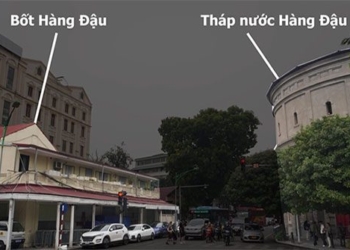How Great Was the Aztec Empire and Who Was Its “Founding Father”?
Before being defeated by the Spanish in 1521, the Triple Alliance led by the Aztecs established a thriving trade system across the vast Mesoamerican region, creating a remarkable Central American culture that endures to this day…
[The historical region of Mesoamerica includes present-day northern Costa Rica, Nicaragua, Honduras, El Salvador, Guatemala, Belize, and central to southern Mexico. For thousands of years, this area was home to groups such as the Olmec, Zapotec, Maya, Toltec, and Aztec peoples – Source: National Geographic].

Left: A statue of a feathered serpent at the Great Temple of Tenochtitlan, in the Valley of Mexico. The massive temple complex was dedicated to Tlaloc, the rain god, and Huitzilopochtli, the god of war. Source: KENNETH GARRETT – Right: Located in Mexico City, the Tlatelolco temple belonged to a city separate from Tenochtitlan. When the Spanish gained control of the area, they dismantled the temple and used its stones to build the Santiago Tlatelolco Church. (Source: CAVAN / ALAMY / ACI).
After the fall of Tenochtitlan – the capital of the Aztec empire, a native poet composed a poignant narrative about the occupation of the Aztec capital. Written in the Nahuatl language, this is the earliest account of the suffering of the Aztecs during war and their defeat exactly 500 years ago in 1521:
“Our legacy, our city, is lost and dead.
The shields of our warriors could not save it.
We had to chew on dry branches and salty grass;
And had to swallow lizards, rats, and worms…”
What remains of Tenochtitlan is now beneath the thriving capital of Mexico – Mexico City – one of the most populous cities in the world.
Surrounded by modern architecture, the archaeological site of Templo Mayor (part of the ancient capital Tenochtitlan) continues to reveal more about the Aztec city and its inhabitants – a reminder of the people and culture that were subdued and assimilated by the colonial regime of New Spain.
Many European chroniclers focused their attention on the conquest by the Spanish Marquis Hernán Cortés and the events of 1521. However, for archaeologists and historians, there is increasing focus on the Aztecs themselves; on how an alliance between ancient cities in Mesoamerica rapidly arose and came to dominate a vast region in history.
Aztec: A Great Empire Indeed
The term Aztec was first coined by an outsider. The Aztecs referred to themselves as Mexica (also Culhua-Mexica); or Tenochca (the name for their capital city, Tenochtitlan).
1. The Codex of the Aztecs
In the early 1800s, the German scientist and explorer Alexander von Humboldt coined the term for the people of Tenochtitlan based on the word “Aztlán,” the traditional name of the ancestral homeland of the Mexica. Archaeologists have yet to pinpoint the exact location of Aztlán, but most place it in northern Mexico.
Much of what is understood about Mesoamerica during the Aztec period comes from documents written by the Mexica themselves or by Spaniards after 1519.
According to ancient records of the Mexica (referred to as Codex), the Mesoamerican region was rich with various cultures and cities, among which, the Aztec culture stood out as the most prominent and affluent. The Mexica (or Aztecs) presented themselves as a people destined to wield power. After overcoming countless obstacles, they ultimately controlled a vast empire.
The Codex recorded the ancestry, work, beliefs, and practices of the Mexica. However, during the Spanish invasion of the 16th century, many ancient records were destroyed, leaving only 5 “surviving” Codexes – these precious records were looted by the Spanish and transported to Europe, where they are now held in various museums.
Production of such records continued after the fall of Tenochtitlan in 1521. Some were written by Spanish colonizers as a means to better understand and control the Mesoamerican peoples.
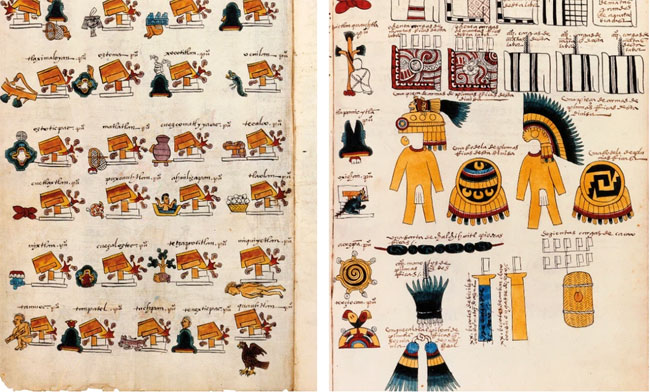
Left: Codex Mendoza, preserved today in the Bodleian Library in Oxford, England, commissioned by Antonio de Mendoza, the first viceroy of New Spain, after the conquest – Right: Codex Mendoza includes detailed descriptions of the tributes that Moctezuma II, who ruled the Aztecs from 1502 to 1520, received. From 400 cities under his control, he received many gifts. In Codex Mendoza, the pictographs correspond to the names of cities, and the images alongside them show their tribute to the ruler Moctezuma II. (Source: BODLEIAN LIBRARY OXFORD / DAGLI ORTI / AURIMAGES)
One of the most famous records is the Mendoza Codex, created in 1542 for Charles V, King of Spain and Holy Roman Emperor. The document contains Aztec writing alongside texts written in Spanish. The first part of the Mendoza Codex lists a series of wars or conquests grouped by each Aztec leader. The second part lists the tribes conquered by the Spanish.
However, no documents of this nature have been found regarding the two ancient areas of Lake Texcoco and Tlacopan – two regions that provided abundant resources for the Aztec capital of Tenochtitlan, where the Aztecs built Tenochtitlan and made it flourish with a population of up to 150,000 to 300,000 people.
Food, raw materials, and textiles came from areas near the city, while luxuries like gold, sweet gum resin, cocoa, and precious feathers came from the far corners of the vast empire.
2. The Power Center of the Triple Alliance
The Aztec people were originally nomadic and migrated to several locations before settling on the islands of Texcoco (also known as the Valley of Mexico), which was under the control of the nearby city of Azcapotzalco.
The Aztecs were once “mercenaries” and were known for their ferocity in battle. They spoke Nahuatl – the dominant language in central Mexico by the mid-1350s. Nahuatl was also the language of the powerful Toltec civilization – who dominated the region between the 10th and 12th centuries and sought to connect with their illustrious ancestors.
Around 1325, the Mexica (or Aztecs) established the capital Tenochtitlan and made it their capital.
Records recount that when the Aztecs saw an eagle perched on a cactus in the marshy land near the southwestern border of Lake Texcoco, they took it as a sign to build their settlement there. They drained the marshy land, constructed artificial islands so they could grow food, and laid the foundations of the capital Tenochtitlán in 1325 AD – which would later become a priceless “jewel” for centuries.
Although the new city thrived, along with other cities including Texcoco, it remained under the control of Azcapotzalco until the lord of Azcapotzalco died in the early 15th century.
When disputes arose over succession, the dominance of Azcapotzalco ended.
In 1428, under the leadership of Itzcoatl, the Aztecs established a Triple Alliance with the Texcoca and Tlacopan to defeat their strongest rival for influence in the region, the Tepanec, and conquer the Tepanec capital of Azcapotzalco. Itzcoatl’s successor, Montezuma I, who came to power in 1440, was a great warrior and is remembered as the father of the Aztec empire.
By the early 16th century, the Aztecs dominated over 500 small states, and approximately 5 to 6 million people, through conquest or trade. Tenochtitlán at its peak had over 140,000 inhabitants and was the most populous city ever to exist in Mesoamerica.
Initially, Texcoco and Tenochtitlan held the highest positions in the hierarchy, with Tlacopan being subordinate to both. Over time, Tenochtitlan (meaning “place of the gods”) of the Aztecs grew the most powerful, and the ruler Motecuhzoma Xocoyotzin (Moctezuma II) [who ruled the Aztec empire from 1502 to 1520] was the most powerful member of the Triple Alliance in the 1500s.
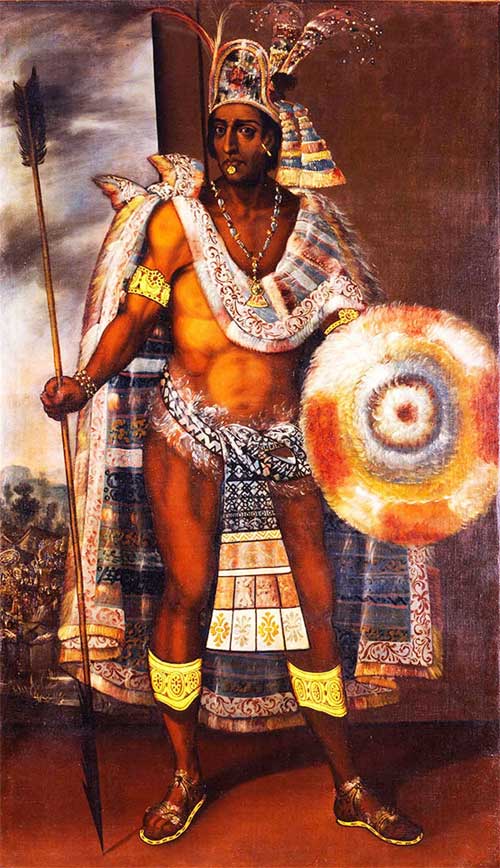
Moctezuma II – Ruler of the Aztec Empire from 1502 to 1520.
Moctezuma II saw himself as the most powerful figure in the Triple Alliance and proposed the idea of an empire centered around the Mexica, an empire that would later be widely known as the Aztec Empire.
Rewinding to the early 1400s, the Triple Alliance took control of Azcapotzalco and other peoples. Some were willing to accept this transfer of power, but others had to be subdued through force.
No significant territorial expansion occurred until a major famine struck the Valley of Mexico from 1450 to 1454. The alliance needed more land to produce food and began conquering city-states.
This process accelerated under Axayacatl – the ruler (tlatoani) of the Aztec, who was also the head of the Triple Alliance.
[Although often translated as “king” or “emperor,” the role of tlatoani (ruler) is inherently less absolute and requires multifaceted leadership].
Axayacatl actively intervened in military, religious, and administrative matters, serving as both a commander and the chief priest of the empire.
The typical crops of the Aztecs included maize, beans, squash, potatoes, tomatoes, and avocados; they also fished and hunted local animals such as rabbits, quails, snakes, coyotes, and wild turkeys. They possessed a relatively complex agricultural system (including land intensive farming and irrigation methods) along with a powerful army, allowing the Aztecs to create a successful state and later a great empire renowned in history.
3. The Fall of a Great Empire – The Footprint of Europeans
In 1481, Tizoc succeeded his brother Axayacatl as the leader of the Aztecs. Although Tizoc’s reign was relatively short, it was during this time that he quelled the uprisings of the Matlatzincan peoples in the Valley of Toluca; he was also the one who commissioned the construction of the Great Pyramid in Tenochtitlan.
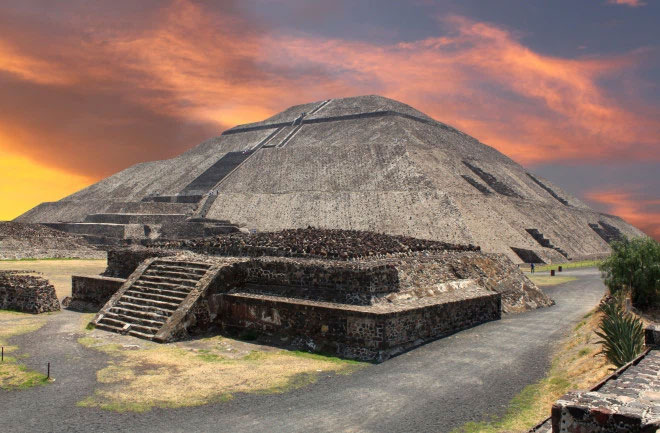
The Great Pyramid of Tenochtitlan, famous of the Aztecs. (Source: Quetzalcoatl1/Shutterstock)
Ruler Tizoc maintained the ancient tradition of pyramid building to honor and worship their gods. Mesoamerican peoples had been constructing pyramids from around 1000 BC until the Spanish invasion in the early 16th century.
[The most well-known Latin American pyramids include the Sun Pyramid and Moon Pyramid at Teotihuacán in central Mexico; the Castillo at Chichén Itzá, in the Yucatán Peninsula; the Great Pyramid in the Aztec capital of Tenochtitlan; the pyramid at Cholula; and the great temple at Cuzco of the Inca in Peru – Source: History Channel].
The carved reliefs indicate that Tizoc conquered 15 city-states. His short reign witnessed uprisings against his rule and how he won victories to strengthen his empire.
According to historians, the greatest ruler of the Aztec empire must be Ahuitzotl – the successor of Tizoc – who was the 8th ruler of the Aztec in the history of this empire.
Upon ascending the throne, Ahuitzotl expanded the borders of the Aztec empire to present-day Guatemala, coming into contact with the lands of the Maya. When Ahuitzotl died in 1502, Moctezuma II became the Aztec ruler and extended the influence of the Triple Alliance into Zapotec areas towards the Pacific.
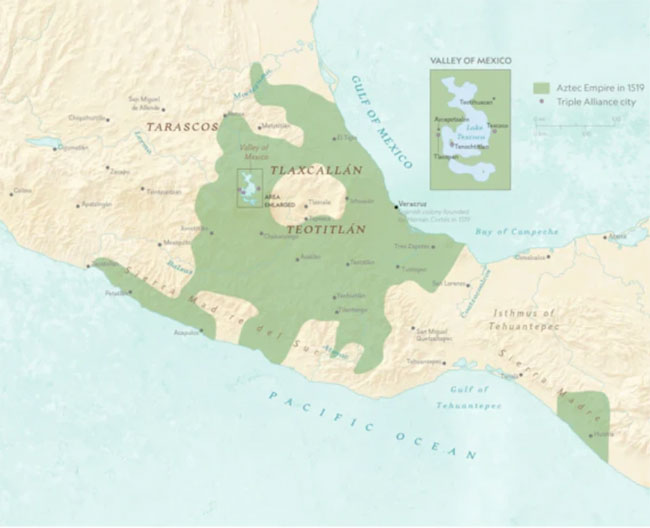
The Triple Alliance (often referred to as Aztec as the Aztec were the most prominent and affluent) conquered lands to control trade routes and raw materials. Scholars believe that religion also played a significant role in the expansion as the Aztecs demanded human sacrifice to maintain cosmic order. (Source: NG MAPS)
During Moctezuma II’s reign, the Spanish began to eye and invade this magnificent empire.
The first Europeans to reach Mexican territory were Francisco Hernandez de Cordoba, who arrived in Yucatán from Cuba with 3 ships and about 100 men in early 1517. In March 1519, Spanish Marquis Hernán Cortés landed in the town of Tabasco, where he learned from the locals about the great Aztec civilization.
Moctezuma II remained in power until Hernán Cortés invaded the Triple Alliance and established the Veracruz colony on April 22, 1519.
4. There Once Was a Great Empire…
Faced with the Spanish invasion, the cities of Mesoamerica chose different paths for survival. Some, like Tlaxcala, opted to ally with the Spanish, while others, like Mexico, chose to fight.
As the world reflects on the events of 1521, there is still much to explore about the story of the Mexica (Aztecs) and their fate when the Spanish arrived in the Americas.
The Aztecs, a nomadic tribe in northern Mexico, arrived in Mesoamerica around the early 13th century. From their magnificent capital, Tenochtitlan, the Aztecs emerged as a dominant force in central Mexico, developing a diverse social, political, religious, and trade organization that brought many cities in the region under their control by the 15th century.
They were highly developed socially, intellectually, and artistically. It was a highly structured society with a strict class system; at the top were the nobility, and at the bottom were serfs, slaves, and captives.
The invaders led by the Spanish conqueror Hernán Cortés overthrew the Aztec Empire by force and captured Tenochtitlan in 1521, ending the last great native civilization of Mesoamerica.
After their victory, Hernán Cortés leveled Tenochtitlan and built Mexico City (the present-day capital of Mexico) on its ruins, rapidly becoming a leading center of Europe in the New World.









































